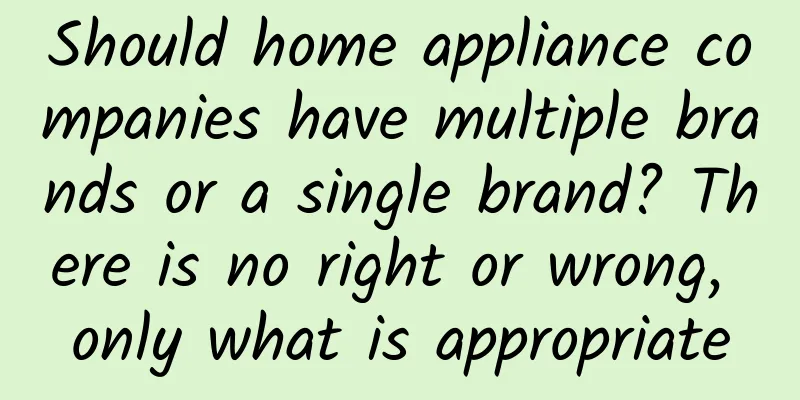Should home appliance companies have multiple brands or a single brand? There is no right or wrong, only what is appropriate

|
As the Chinese home appliance industry collectively goes overseas and faces more and more demands from different audiences, the relevant enterprises have to consider whether to choose multiple brands or a single brand before filing a case. This also tests the operation and control capabilities of home appliance enterprises over brands. All in: You are my customer no matter what When you stand in front of the supermarket shelves, you see a wide variety of food and beverages. You choose this brand of yogurt, that brand of juice, and another brand of biscuits. But you may not know that no matter how you combine and choose, these products may all come from the same company. They may be Nestle, Mondelez, Unilever, PepsiCo, and Nongfu Spring. Multi-brand operation is almost a standard feature of multinational companies, a typical example being the fast-moving consumer goods industry. Some group companies have so many brands that it is unimaginable. Nestle, the world's largest food and beverage company, owns more than 2,000 brands; Unilever owns more than 1,000 brands, including 13 billion-euro brands in the world; Procter & Gamble has 65 leading brands in the world, including 25 billion-dollar brands; Coca-Cola owns more than 500 brands, including 20 brands with annual sales of more than 1 billion dollars; PepsiCo has 22 brands with annual retail sales of more than 1 billion dollars; Mars now owns 10 brands worth more than 1 billion dollars; Under the management of Warren Buffett, the stock god, the merged Heinz Kraft now has eight brands worth more than $1 billion and five brands worth between $500 million and $1 billion. Mondelez (Kraft's predecessor) has at least 13 brands that are well known to Chinese people. Moreover, the businesses and categories of these companies cover all segments of food and beverages. Even domestic food and beverage companies mostly choose to operate under multiple brands and vigorously develop product brands. For example, Dali Group owns well-known brands such as Dali Garden, Haochidian, Kebick, Heqizheng, Lehu, and Doubendou, each of which is responsible for different product business segments. Another example is Nongfu Spring. Its innovation in product innovation and packaging design in recent years is obvious to all. Now it is trying hard to build product brands, and the parent brand only appears as an endorsement image, such as Nongfu Orchard, Water-soluble C100, and Scream in the past, and now Tea Pi, Milk Tea, and Power King Vitamin Water. Nongfu Spring Company not only owns the well-known Nongfu Spring brand, but also has created a number of brand matrices. So, no matter what, you are my customer. For the first: Buy, buy, buy for development The reason why food and beverages choose to use a multi-brand model is largely related to the business content involved. Residents' food safety is the top priority. If a food safety accident occurs, the blow to the brand may be fatal, see the Sanlu milk powder incident. The biggest advantage of choosing a multi-brand model is that when a problem occurs in a certain business or a certain type of product under a brand, it will not affect other brands and businesses. Correspondingly, the biggest advantage of adopting a single brand is that resources (especially communication resources) can be used to the maximum extent. At present, there are also many enterprises in the home appliance industry that operate multiple brands. For example, Haier Group now has more than ten brands: Haier, Casarte, RRS, GEA, AQUA, Fisher & Paykel, Leader, DCS, MONOGRAM, etc., each brand has its own market positioning. Midea Group owns more than ten brands including Midea, Little Swan, Welling, Hualing, Ande, Midea, Kuka, etc. Hisense Group owns brands such as Hisense, Rongsheng, Kelon, etc. Gree Group owns brands such as Gree, Dasong, Jinghong, etc. In terms of brand volume, the home appliance industry is far less than the food and beverage industry. However, this is also related to the industry attributes and development history. Fast-moving consumer goods companies pay attention to brand strength, and the more brands they have, the better. Moreover, when a company develops to a certain extent and wants to expand, mergers and acquisitions are almost the only way. Especially when giant companies expand their business and see a certain development trend, they will quickly take down many emerging companies that have started, and then integrate and digest them through a huge supply chain and marketing system. For example, Coca-Cola targeted the explosive growth of functional beverages and quickly acquired Monster Beverage, an energy drink producer, for $2.15 billion. Last September, Monster Beverage from the United States was launched in China, and quickly used Coca-Cola's channels to open up the market and compete with Red Bull. So in convenience stores, you will see a bottle of Coca-Cola next to a bottle of functional beverage with claws on the package. This is Monster. As long as it is for the purpose of development and profit, not only giants are launching mergers and acquisitions of emerging companies, but even giants are acquiring and adjusting each other. Previously, PepsiCo divested its catering businesses such as KFC and Pizza Hut; Kraft, the former world's second largest food company, split its global business into Mondelez International and Kraft Foods in 2012; Nestle acquired Pfizer's nutrition products department Wyeth; Buffett merged Heinz and Kraft to form the world's fifth largest food and beverage company, and even the dispute over Kraft Heinz's acquisition of Unilever that was reported at the beginning of this year. From this perspective, multinational giants are good at using capital to manage and combine brands. They play with brands and have extremely high capabilities in operating and controlling brands. However, many Chinese companies currently lack the ability to control multiple brands. As my country's home appliance companies expand around the world, including Haier and Midea, they frequently use capital means such as mergers and acquisitions to integrate other brands, supplement current businesses or meet the needs of corporate strategic development. And with the rise of the mainstream consumer class born in the 1980s and 1990s, especially the prominence of the middle class, home appliance companies will inevitably consider meeting more segmented and personalized user needs, but sometimes the image of the parent brand may not meet this condition, so they need to consider creating new brands. However, there is no absolute answer to whether to have multiple brands or a single brand. The choice of brand architecture requires comprehensive consideration of many factors. There is no perfect brand model, and there is no right or wrong, only the right one! As a winner of Toutiao's Qingyun Plan and Baijiahao's Bai+ Plan, the 2019 Baidu Digital Author of the Year, the Baijiahao's Most Popular Author in the Technology Field, the 2019 Sogou Technology and Culture Author, and the 2021 Baijiahao Quarterly Influential Creator, he has won many awards, including the 2013 Sohu Best Industry Media Person, the 2015 China New Media Entrepreneurship Competition Beijing Third Place, the 2015 Guangmang Experience Award, the 2015 China New Media Entrepreneurship Competition Finals Third Place, and the 2018 Baidu Dynamic Annual Powerful Celebrity. |
>>: Jia Yueting is the only FF founder left, and FF is close to running out of funds
Recommend
How can such a low-level product advertising creativity generate sales of over 100 million?
The product advertisement I share with you today ...
People can taste tens of thousands of flavors, not relying on the tongue, but on the nose
Eating is the basis for the survival of all anima...
It's not just the workers who have to compete, the competition for ribosomes is not easy either!
Nowadays, competition is rampant in all walks of ...
The turtle is lying on its back, can it still turn over by itself?
In his crosstalk "On Dreams", Guo Degan...
Which technology products have influenced you in 2016?
2016 was a turbulent year for the technology indu...
Does water boiled in electric kettles damage nerves and cause cancer? You should really drink less of these 3 types of water in summer!
There are rumors that stainless steel electric ke...
B station nanny-level delivery tutorial
When a brand is starting up, it often struggles w...
No idea for event planning? Look here!
The creativity of an event is often an important ...
Apple releases iOS16 Beta 2! Let's take a look at what's updated
Apple recently pushed the iOS/iPadOS 16 Developer...
Is Internet design a job for young people? My thoughts after working for Huawei for five years
When I just graduated, I heard from my seniors th...
Sleeping, breeding, becoming an internet celebrity, astronauts have "new careers"
On July 24, the Long March 5B carrier rocket &quo...
The prices of the first batch of 5G mobile phones were exposed, and netizens said: I can’t afford it!
Recently, there has been more and more news about...
Doulele·Douyin unblocking encyclopedia, helping you solve various difficult and complicated problems (banning words and templates)
Doulele·Douyin unblocking encyclopedia, helping y...
These 4 breakfast combinations are not recommended for you to eat every day! Milk and eggs are on the list?
The pace of life is getting faster and faster, an...
Building iOS Routers Step by Step
Continue from the previous article Mobile termina...









